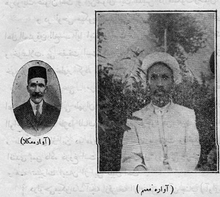Abd al-Hosayn Ayati: Difference between revisions
m →Works: added citation |
m →Works: used a better image |
||
| Line 4: | Line 4: | ||
{{Article for deletion/dated|page=Abd al-Hosayn Ayati|timestamp=20210101165457|year=2021|month=January|day=1|substed=yes}} |
{{Article for deletion/dated|page=Abd al-Hosayn Ayati|timestamp=20210101165457|year=2021|month=January|day=1|substed=yes}} |
||
<!-- Once discussion is closed, please place on talk page: {{Old AfD multi|page=Abd al-Hosayn Ayati|date=1 January 2021|result='''keep'''}} --> |
<!-- Once discussion is closed, please place on talk page: {{Old AfD multi|page=Abd al-Hosayn Ayati|date=1 January 2021|result='''keep'''}} --> |
||
<!-- End of AfD message, feel free to edit beyond this point --> |
<!-- End of AfD message, feel free to edit beyond this point -->[[File:Avareh.png|thumb|'''Abd al-Hosayn Ayati as a cleric (right) and as a Baha'i (left)''']] |
||
[[File:Husayn Ayati.jpg | thumb|'''Abd al-Hosayn Ayati''']] |
|||
'''Abd al Ḥosayn Ayati''' (1871—1953) was a Persian cleric, poet, historian, journalist, and teacher. Up until the age of 30 he was a Shia cleric who then converted to the Baha'i faith.<ref>{{Cite journal|last=Narges|first=Dehghanian|date=2009|title=نمکدان دفتر ادبیات شعر و نغز دوره اول پهلوی|url=https://archive.org/download/20210101_20210101_2254/%D9%86%D9%85%DA%A9%D8%AF%D8%A7%D9%86%20%D8%AF%D9%81%D8%AA%D8%B1%20%D8%B4%D8%B9%D8%B1%20%D9%88%20%D9%86%D8%BA%D8%B2.pdf|journal=Payame Baharestan|volume=1388:3|pages=473-478|via=http://ensani.ir}}</ref> He left the Baha'i faith 18 years later and wrote a number of polemical works describing his experience and why he reverted back to Shia Islam. ٌWhile a [[Baháʼí Faith|Baháʼí]] he was a contemporary of [[ʻAbdu'l-Bahá]], who gave him the titles of "Raʾīs-al-moballeḡīn" (Chief of Missionaries) and "Avarih" (Wanderer).<ref name=":0" /> |
'''Abd al Ḥosayn Ayati''' (1871—1953) was a Persian cleric, poet, historian, journalist, and teacher. Up until the age of 30 he was a Shia cleric who then converted to the Baha'i faith.<ref>{{Cite journal|last=Narges|first=Dehghanian|date=2009|title=نمکدان دفتر ادبیات شعر و نغز دوره اول پهلوی|url=https://archive.org/download/20210101_20210101_2254/%D9%86%D9%85%DA%A9%D8%AF%D8%A7%D9%86%20%D8%AF%D9%81%D8%AA%D8%B1%20%D8%B4%D8%B9%D8%B1%20%D9%88%20%D9%86%D8%BA%D8%B2.pdf|journal=Payame Baharestan|volume=1388:3|pages=473-478|via=http://ensani.ir}}</ref> He left the Baha'i faith 18 years later and wrote a number of polemical works describing his experience and why he reverted back to Shia Islam. ٌWhile a [[Baháʼí Faith|Baháʼí]] he was a contemporary of [[ʻAbdu'l-Bahá]], who gave him the titles of "Raʾīs-al-moballeḡīn" (Chief of Missionaries) and "Avarih" (Wanderer).<ref name=":0" /> |
||
Revision as of 23:20, 1 January 2021
This article needs additional citations for verification. (July 2013) |
You can help expand this article with text translated from the corresponding article in Persian. (October 2013) Click [show] for important translation instructions.
|
An editor has nominated this article for deletion. You are welcome to participate in the deletion discussion, which will decide whether or not to retain it. |

Abd al Ḥosayn Ayati (1871—1953) was a Persian cleric, poet, historian, journalist, and teacher. Up until the age of 30 he was a Shia cleric who then converted to the Baha'i faith.[1] He left the Baha'i faith 18 years later and wrote a number of polemical works describing his experience and why he reverted back to Shia Islam. ٌWhile a Baháʼí he was a contemporary of ʻAbdu'l-Bahá, who gave him the titles of "Raʾīs-al-moballeḡīn" (Chief of Missionaries) and "Avarih" (Wanderer).[2]
In 1920s, Shoghi Effendi sent Avarih to England to teach the Baháʼí Faith. Former member of the Universal House of Justice, Luṭfu'lláh Ḥakím, served as his translator during this visit.[3]
After reverting to Islam he openly opposed the Baháʼí Faith and was considered a Covenant-breaker. He returned to Tehran and spent the rest of his life as a secondary school teacher.During this period he wrote Kashf al-Hial, a three volume work refuting the Baháʼí Faith.[2] He was labelled by Shoghi Effendi as a "shameless apostate".[4]
The numerous references made to Avarih in John Esslemont's book Baháʼu'lláh and the New Era were removed in subsequent editions published after Avarih's apostasy from the Baháʼí Faith.[5]
Works

- َAtashkadeh Yazdan (God's Fireplace): A book on the history of the city of Yazd in Iran.[6]
- Farhang-i Ayati (Ayati's Dictionary): A Persian-Arabic dictionary.[7]
- Al-Kawākeb al-dorrīya fī maʾāṯer al-bahāʾīya (Shining Stars of Baha'i Remnants): a work on history of Baháʼí Faith.[8]
- Kašf al-ḥīal (Uncovering the Deceptions): his work in three volumes after leaving the Baháʼí Faith where he explains why he left the Baha'i faith and explains the wrongs that he witnessed.[8] Vol. 1, Vol. 2, vol. 3.
- Siyahat nam-i doctor jack amricaiee (The travel diary of Dr Jack the American): Real life accounts narrated as a story about the life of a foreigner investigating the Baha'i claims during his travels that Ayati refers to using the pseudonym Jack the American.[9]
- Moballighe Baha'i dar mahzar-e ayatollah shaykh mohammad khalesi zadeh (A Baha'i Missionary in the Presence of Shaykh Muhammad Khalesi Zadeh): The report of Iranian Army personnel from Yazd that were proselytized by a Baha'i missionary and decided to consult Ayatollah Khalesizadeh about the Missionaries claims.[10]
References
- ^ Narges, Dehghanian (2009). "نمکدان دفتر ادبیات شعر و نغز دوره اول پهلوی" (PDF). Payame Baharestan. 1388:3: 473–478 – via http://ensani.ir.
{{cite journal}}: External link in|via= - ^ a b Afshar, Iraj (2011). Encyclopaedia Iranica: ĀYATĪ, ʿABD-AL-ḤOSAYN. p. 133.
- ^ "Star of the West/Volume 14/Issue 1/Text - Bahaiworks, a library of works about the Bahá'í Faith". bahai.works. Retrieved 2020-09-18.
- ^ Maxwell, Ruhiyyih (Mary Khanum) (1969). The Priceless Pearl. London: Baháʼí Publishing Trust. p. 120.
- ^ Salisbury, Vance (1997). "A Critical Examination of 20th-Century Baha'i Literature". Baháʼí Library Online. Retrieved December 8, 2016.
- ^ Ayati, Abd al-Husayn (1938). آتشکده یزدان. Yazd (Iran).
{{cite book}}: CS1 maint: location missing publisher (link) - ^ Ayati, Abd al-Husayn (1935). فرهنگ آیتی. Tehran (Iran): Matba Danesh.
- ^ a b Afshar 2011. sfn error: multiple targets (2×): CITEREFAfshar2011 (help)
- ^ Ayati, Abd al-Husayn (1927). سیاحت نامه دکتر ژاک آمریکایی (PDF). Tehran: Khavar.
- ^ Ayati, Abd al-Husayn (1987). مبلغ بهایی در محضر آیت الله خالصی زاده (PDF). Iran (Yazd): Golbahar.
- Afshar, Iraj (August 18, 2011). "ĀYATĪ, ʿABD-AL-ḤOSAYN". Encyclopædia Iranica.
